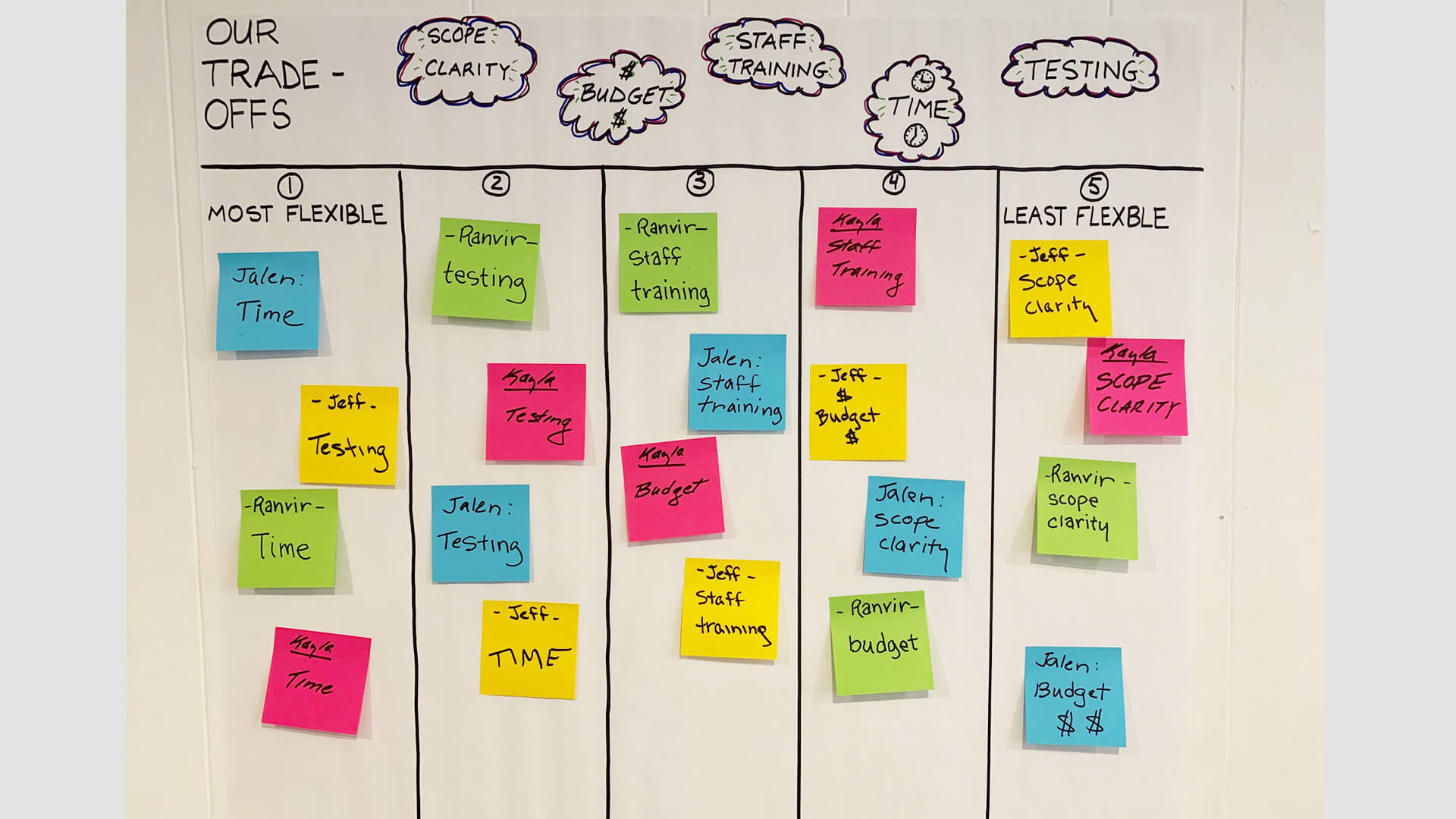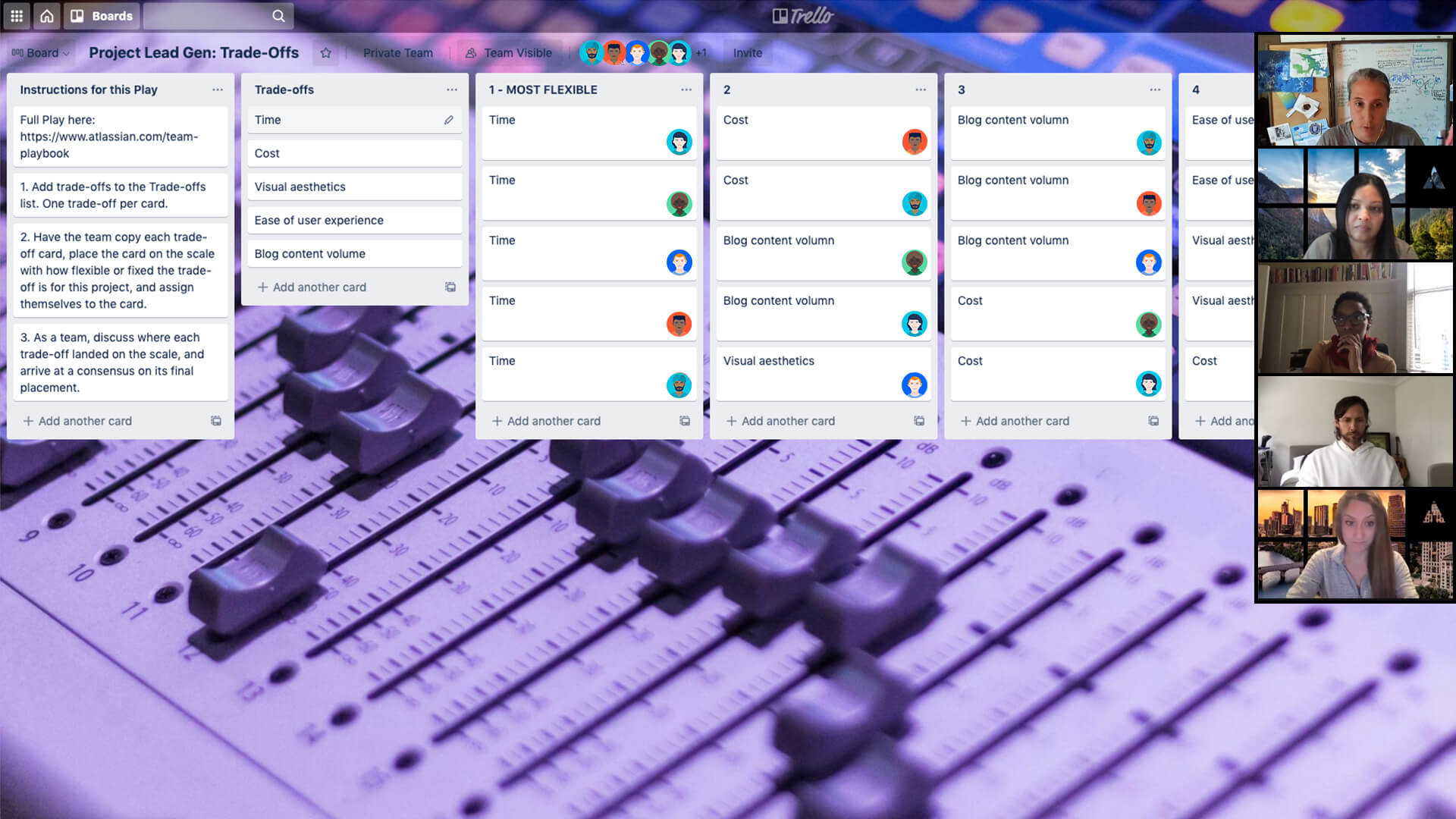Project Trade-Off Analysis
Every project has trade-offs, such as cost or scope. Define and prioritize them to invest resources wisely and meet your important goals.

PREP TIME
10m
Run TIME
50m
Persons
3-5
5-second summary
- Discuss project trade-offs such as cost, scope, quality, time, and risk.
- Review information that may change how your team decides trade-offs.
- Rate which trade-offs should be made first vs. last.
WHAT YOU WILL NEED
- Meeting space or video conferencing with screen sharing.
- Digital collaboration tool (see templates).
- Optional: Whiteboard, markers, sticky notes, and timer.
PLAY resources
How to analyze project trade-offs
Prioritize trade-offs to invest resources wisely and meet your most important goals.
What is a project trade-off?
Project trade-offs are the decisions that involve sacrificing one aspect of a project to achieve another, such as cost, scope, quality, time, or risk.
Why run the Project Trade-off Analysis Play?
Every project has trade-offs.
Could you complete the project faster? Yes, but you might need to spend more money or risk overworking team members or reducing quality.
Could you cut costs? Yes, but then the final product might not fully meet user needs, or the project might take longer to complete.
Running the Project Trade-off Analysis Play helps teams analyze these trade-offs, make strategic decisions, and stay aligned throughout the project.
When should you analyze project trade-offs?
Running this Play at the beginning of a project sets everyone up for success and can help overcome obstacles faster if or when trade-offs must be made.
Revisit this Play if your team uncovers new information and/or if priorities need to change.
The benefits of analyzing project trade-offs
Research summarized in the book Project Management: A Benefit Realisation Approach shows that defining project parameters and tradeoffs early benefits teams in several ways.
- More alignment with strategic objectives
By clearly outlining the desired benefits, the project's scope, and the associated parameters, a project team can focus its efforts on activities that directly contribute to achieving those strategic goals. This prevents scope creep and keeps the project on track. - More informed decision-making
When project teams establish parameters like budget, timeline, and quality standards upfront, it becomes easier to evaluate different options and make trade-offs that increase the likelihood of realizing benefits. This avoids costly rework or changes later in the project. - More stakeholder engagement and buy-in
By involving stakeholders in the initial stages of defining project parameters and exploring potential trade-offs, project teams can gain valuable insights, address concerns, and build consensus. This fosters a shared understanding of the project's goals and increases the likelihood of stakeholder support throughout the project. - More effective risk management
By identifying potential risks and constraints early, project teams can create mitigation strategies and contingency plans. Understanding the trade-offs associated with different risk responses helps teams make more informed decisions about how to manage those risks.
1. Prep the Play
Est. time: 10 MIN
Start a digital collaboration document, such as a Trello board or a Confluence page. If your team is meeting in person, you can also use a whiteboard or large piece of paper. (You’ll want to transfer notes into the digital document afterward for reference.)
Next, start a list of project trade-offs in your digital document or physical board for the team to add to. Write down one trade-off per sticky note or card. For example, costs, time, and scope are some of the most common project trade-offs.
Then, create columns on your document or board labeled 1 through 5. The “1” column will represent the most flexible trade-offs (the ones that will be made first), and the “5” column will represent the least flexible (the ones that will be made last).
2. Set the stage
Est. time: 5 MIN
Getting everyone on the same page from the start helps ensure a smooth meeting. At the beginning of the session, tell the team:
- The goal of this session is to reach an agreement on the project’s priorities so that when we need to make trade-offs, we’re in agreement about how to do that.
We should use our experience on past projects to inform our recommendations.
If there are team members who haven’t done a trade-off analysis before, walk them through the next steps before getting started so they understand the process.
3. Add to the list
Est. time: 10 min
Give the team 5-10 minutes to add trade-offs to the board or paper. Encourage them to write down whatever comes to mind, creating a safe space for any and all ideas.
TIP: Acknowledge the exchange
Trade-offs require giving up one thing to get more of another. Spending more time, money, and/or effort on one item often comes at the expense of a different item. Be honest with yourself and with each other about these benefits and sacrifices.
4. Rate flexibility
Est. time: 10 min
Ask each team member to add a card or sticky note for each trade-off on a scale from 1 to 5. Remember: Cards or notes rated as “1” are the trade-offs with the most flexibility, and those rated “5” have the least flexibility.
A flexible trade-off can be negotiated so the team can focus on higher priorities. For example:
-
If there’s no deadline on the project, time is a “1.” Other things are a higher priority, even if they require extending the timeline.
-
If there’s a strict budget, cost is a “5”. The cost can't increase, even if that means that it takes longer or the scope has to be reduced.
Make sure team members put their names on their cards or sticky notes so everyone is aware of how different team members view the trade-offs.
The idea here is not to call people out, but to foster open discussion around why a given trade-off received that rating. For example, someone might have some insight into why costs should be less flexible. (And they can share that information in the next step!)
TIP: Dig Deeper
If everything is the highest or lowest priority, this Play won’t help the team make decisions.
If everything is rated a “5” (least flexible), ask the team, “Which trade-off delivers the most benefit to our users/customers?” and/or “Which one aligns most with our company values?”
If everything is rated a “1” (most flexible), ask, “Between these trade-offs, which one(s) would we make first?” Then, adjust ratings accordingly.
5. Discuss
Est. time: 15 min
Once everyone has noted their initial ratings, take a look at where the trade-offs fall on your scale of 1-5. Discuss any clear themes or commonalities where multiple team members gave a trade-off the same rating.
Then, move on to any trade-offs with different ratings. Discuss each team member’s reasoning for the placement, and make notes of any useful feedback.
6. Update
Est. time: 10 min
As you discuss trade-offs and reach a consensus on their flexibility, move the cards or sticky notes to the appropriate list to reflect the updated rankings.
Follow-up
Document
If your team met in person and used a physical whiteboard or piece of paper, document your notes and rankings in a digital document, such as a Confluence page. That way, the team and stakeholders can see and revisit these trade-offs if questions come up in the future.
Revisit
Revisit this Play if your team uncovers new information and/or if priorities need to change.
Variations
Include leaders
If leaders are the final decision-makers about project trade-offs, run the Play with project leaders or business stakeholders rather than (or in addition to) the team that is executing the work.
If your team is the final decision-maker, you could still run the Play with leadership and implementation teams separately and then compare results to uncover potential areas of misalignment.
One at a time
Rather than discussing all trade-offs at once, introduce them one at a time to keep everyone focused on the same item. Discuss each ranking before moving on to the next. It can be eye-opening to see if or how your rankings change as each new trade-off is added.
Walk the board
Instead of going through your trade-offs and ratings one by one, start with any items that are blocked and discuss how to unblock them. Then, go through each remaining item and discuss how to complete it.

Still have questions?
Start a conversation with other Atlassian Team Playbook users, get support, or provide feedback.
Other plays you may like
Goal-setting
OKRs
Define what objectives to achieve and track progress with measurable key results.
Decision-making
DACI Decision Making Framework
Assign clear roles to ensure effective collaboration and accountability during the decision-making process.
Decision-making
Tradeoffs
Define and prioritize your project variables.
PROJECT PLANNING
Project poster
Focus your thinking, share ideas and updates, and define success.
Stay up to date
Get the latest Plays and work life advice when you sign up for our newsletter.







